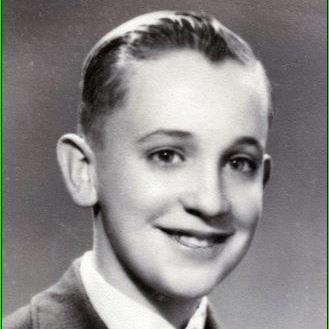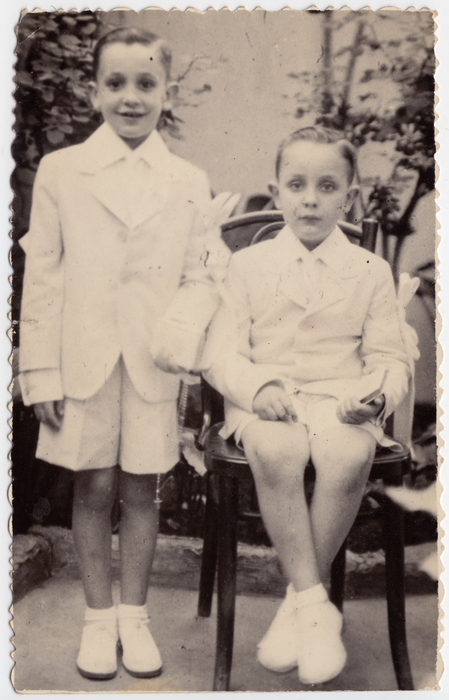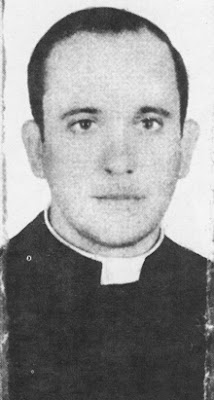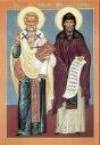
Just before Christmas 1936, Regina Bergoglio gave birth to her first child, who she named Jorge, which is Spanish for George. As she held her baby boy in the intense sunshine of an Argentinean summer, little did she know that she was nurturing a future Pope.
In 1929 Regina and her husband Mario had emigrated from Piedmont in northern Italy and had started their family in the Americas. Mario toiled on the railway, while Regina became a full-time housewife and devoted her life to her five children. They had a modest existence, being so thrifty that new clothes were seen as dangerously lavish, not once going on holidays and never owning a car.
They were not poor, but were unassuming upper-working-class Italians who considered themselves very fortunate to have secure housing in Flores, an ordinary suburb of Buenos Aires, a city that had its share of squatter settlements and slums. Many of Mario Bergog-lio’s fellow workers on the railroads would have lived in shanty towns.
At the time, migrants from different parts of Argentina and from Europe were trying to eke out an existence in Buenos Aires – or at least get a menial job. Society in Buenos Aires in the 1930s was stubbornly Victorian and priggish. High Victorian fashions were still de rigeur. Even the slightest bad etiquette was frowned upon. People were not easily forgiven for having come from a lower class, and the rich and poor classes painfully chafed against each other. The Bergoglios were different: unlike many of their contemporaries, they were cultured but not obsessed with social climbing.
Regina and Mario could not abide wasting food and ensured that their children cleaned their plates at meal times. Regina was an excellent cook and diligently taught Jorge how to cook all manner of Italian dishes. When he was growing up, on Saturdays Jorge would sit with his mother and listen to opera on the radio. Reminiscing about this he has said: “It was just the most lovely thing.” The Bergoglios were keen to assimilate and did not mix exclusively with other Italians. Also, snubbing the poor and resenting the penurious because they cast shadows of misfortune on the great city of Buenos Aires was not their approach. It was here, in 1940s Buenos Aires, seeing emaciated children go hungry while richer people in furs scorned them for their lowliness, that the future Pope began to abhor snobbery.

The young Jorge was bookish, busy cultivating his love for literature and dazzled by the colourful local Jewish community, which put on plays. Known for his literary leanings, his chief field of study, however, was chemistry, a subject in which he earned a Master’s degree.
As a young man, he had a wide circle of friends and a girlfriend with whom he danced the tango, until the stirrings of a vocation caused him to break from his sweetheart and give up dancing. He told Francesca Ambrogetti and Sergio Rubin, the authors of his 2010 biography, that his ex-girlfriend “was one of the group of friends I went dancing with. But then I discovered my religious vocation.” He entered the Society of Jesus as a 21-year-old, which was then considered a slightly late vocation. In his early 20s, an unshakable lung infection and lack of the right treatment meant that he lost a lung. He was ordained in December 1969, a few days before he turned 33.
Having impressed his superiors when he was novice master of the San Miguel seminary, he was only 37 when he was elected superior of the Jesuit province of Argentina. His decision-making during this time is the most highly contested period of his biography. Present-day Argentina is still grappling with the memories of the military’s violent rule from 1976 to 1983. Allegations persist that Pope Francis was complicit in the regime of Jorge Rafael Videla. The then Fr Bergoglio was the highest-ranking Jesuit in Buenos Aires and has since been pilloried for not speaking out against the junta’s abuse of power. At the time, army generals were attempting to rid society of people who they suspected were Left-wing subversives.

What is certain is that during the “Dirty War” he demanded absolute obedience and political neutrality of his priests, something that many of them greatly resented. The Jesuit order was showing cracks because of infighting, as many priests were seduced by a blend of Marxism and Liberation Theology, and rebelled against the traditional nature of a priestly vocation.
One man who is leading the charge against Pope Francis is journalist Horacio Verbitsky, who in his 2005 book The Silence accuses him of allowing the military to use the Jesuit headquarters as a secret base. Denying this allegation, Pope Francis says he gave a home to dissidents in the Jesuits’ mother house. An even more contentious sequence of events involves two Jesuits, Fr Orlando Yorio and Fr Francisco Jalics, who in the 1970s were evangelising and starting literacy programmes in the shanty town Belén-Bethlehem. The military panicked, believing that such work could spark a rebellion in the slums. Fr Bergoglio gave Fr Yorio and Fr Jalics an order to stop going to Belén-Bethlehem. But a conflict arose between the zealous Fr Yorio and Fr Jalics, who wanted to educate the disadvantaged and their superior, Fr Bergoglio, who didn’t want them to lose their lives. Fr Yorio and Fr Jalics defied Fr Bergoglio and were arrested by the navy in May 1976. Later Fr Yorio claimed that he and Jalics and several youth workers were arrested because Fr Bergoglio “withdrew his protection” from them and this gave the army “a green light” to arrest him. But Pope Francis insisted in his biography that ordering them to stop going to the slums was the only way to ensure they wouldn’t be killed. The then Fr Bergoglio was not a member of the military and, even if he had been, he would have had little power to assuage the generals’ paranoia that there would be a proletarian uprising, aided by energetic young Jesuits who would empower the “subversives”.

There is also controversy surrounding babies, born to captives, who were covertly adopted by pro-junta families after the mothers were killed. Some claim that in the 1970s Pope Francis was privy to information about these babies who were being taken from their mothers. In 2010, when he was Archbishop of Buenos Aires, he appeared in a court that was uncovering what had happened to the babies. He testified that it wasn’t until 1985 that he knew that the babies of “subversives” were being given to supporters of Videla.
Fr Bergoglio’s six years as a leader in the Jesuit community were hard on his nerves, and in 1980 he returned to the seminary in San Miguel as rector. Going from provincial superior to rector was both peculiar and seen as somewhat of a self-imposed demotion, but he remained in this post until 1986. He put his culinary talent to full use and cooked for the students. On hearing the compliment that he was a good chef, he replied: “Well, nobody has died yet from my cooking.”
A key awakening in his spiritual life happened in 1985, when he attended a rosary that was being led by Blessed Pope John Paul II. He described it in these words: “In the middle of the prayer I became distracted, looking at the figure of the Pope: his piety, his devotion was a witness… and the time drifted away, and I began to imagine the young priest, the seminarian, the poet, the worker, the child from Wadowice… in the same position in which knelt at that moment, reciting Ave Maria after Ave Maria. His witness struck me… I felt that this man, chosen to lead the Church, was following a path up to his Mother in the sky, a path set out on from his childhood. And I became aware of the density of the words of the Mother of Guadalupe to St Juan Diego: ‘Don’t be afraid, am I not perhaps your mother?’ I understood the presence of Mary in the life of the Pope.”
From that day onwards, Pope Francis has recited the 15 mysteries of the rosary every day. That moment, when he was struck by John Paul II’s example, may have renewed his vim and vigour as a leader, something that had been sorely tested in the 1970s.
In 1992 he was appointed auxiliary bishop of Buenos Aires. In contrast to the Jesuits of the 1970s, the ordinary clergy of the diocese grew fond of their bishop. He did something simple but revolutionary: setting up a phone line that was exclusively for priests who needed to call him and he would encourage them to use it, day or night. Bishop Bergoglio had a strict code of coming in person to the aid of his priests, staying with them in crises, or keeping a bedside vigil with priests who were elderly and in poor health. In contrast to his earlier reputation for being somewhat indifferent to the people subsisting in the shanty towns, he was known in the early 1990s as a bishop who would keep tabs on precisely how his priests were helping poorer parishioners. He spent his days travelling around the diocese, so that he could keep poor people company, help out in soup kitchens and visit Aids victims. His schedule was gruelling and one of his few luxuries was taking refuge in a good novel.
The poverty-stricken children who were his peers when he was a youngster in the 1940s were in his thoughts and he was determined to use his prominence as a bishop to better the lot of the impoverished, as opposed to rubbing shoulders with the Argentinean elite. He eschewed ostentation, showiness and glamour. Journalists dogged his heels, wanting exclusive interviews, and social climbers sought photo opportunities, but with a famously understated smile, and a reserved manner, he refused interviews and walked away from them. This man for all seasons would never be their man.
Source

